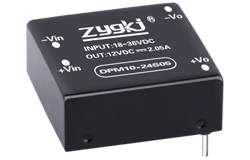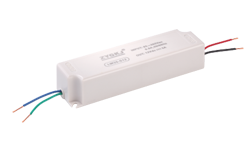nyheder
Bidirectional DC DC Converter: A Two-Way Power Transfer Solution
Author: ZYG Power Module Time: 2023-6-12
A bidirectional DC-DC converter is a power transfer solution that allows for two-way power conversion between two different voltage levels. This type of converter is commonly used in applications where power needs to be transferred bidirectionally, such as in electric vehicles, renewable energy systems, and battery charging systems.
The bidirectional DC-DC converter is a device that converts power from a high voltage level to a low voltage level, or vice versa, depending on the direction of power flow. This is achieved by using a combination of power switches, inductors, capacitors, and control circuitry.
The converter operates in two modes: buck mode and boost mode. In buck mode, the converter steps down the voltage from the high voltage level to the low voltage level. In boost mode, the converter steps up the voltage from the low voltage level to the high voltage level. The direction of power flow determines which mode the converter operates in.
The bidirectional DC-DC converter has several advantages over other power transfer solutions. One of the main advantages is its efficiency. The converter is designed to minimize power losses and maximize power transfer efficiency, which results in less energy wasted and more energy transferred between the two voltage levels.
Another advantage of the bidirectional DC-DC converter is its flexibility. The converter can be used in a variety of applications and can handle a wide range of voltage levels. This makes it an ideal choice for applications where power needs to be transferred bidirectionally between two different voltage levels.
In addition, the bidirectional DC-DC converter is compact and lightweight, which makes it easy to integrate into existing systems. This compact design also helps to reduce the overall cost of the system, as fewer components are required to achieve the same level of power transfer efficiency.

Despite its many advantages, the bidirectional DC-DC converter also has some limitations. One of the main limitations is its complexity. The converter requires a sophisticated control circuitry to ensure that the power transfer is efficient and reliable. This complexity can increase the cost and complexity of the overall system.
Another limitation of the bidirectional DC-DC converter is its susceptibility to electromagnetic interference (EMI). The high-frequency switching signals used by the converter can generate EMI, which can affect other components in the system and reduce overall system performance.
In conclusion, the bidirectional DC-DC converter is a two-way power transfer solution that offers several advantages over other power transfer solutions. Its efficiency, flexibility, and compact design make it an ideal choice for applications where power needs to be transferred bidirectionally between two different voltage levels. However, its complexity and susceptibility to EMI may limit its use in certain applications.
Tidligere: Bidirectional DC-DC Converter: A Versatile Power Conversion Solution
Næste: DC DC Converter EX Series: Advanced Power Conversion Solutions
relevant information
-
2023-7-27
In today's rapidly advancing technological world, the demand for efficient power conversion solutions is higher than ever. Whether it's for consumer electronics, automotive, telecommunications, or renewable energy, the need to effectively convert direct current (DC) voltage levels has become a critical aspect of modern engineering. Addressing this crucial requirement, we are proud to introduce the DC DC Converter EX Series, a cutting-edge power conversion solution that offers enhanced performance and versatility for all your power conversion needs. The DC DC Converter EX Series is designed to provide a seamless and efficient conversion of DC voltage levels, ensuring optimal power delivery in various applications. With a wide input voltage range and high voltage conversion efficiency, this series offers superior performance and...
Se detaljer -
2023-4-16
Generating DC Power: Understanding AC-DC Converters
In today world, electricity is a crucial part of our daily lives. Everything from our homes to our workplaces to our smartphones is powered by electricity. But not all devices are powered by the same type of electricity. Some devices require direct current (DC) power, while others require alternating current (AC) power. AC power is the type of electricity that is delivered to most homes and businesses. It is called alternating current because it switches direction many times per second, typically 60 times in the United States. In contrast, DC power flows in one direction only. AC-DC converters are devices that transform AC power into DC power. They are used in a wide range of applications, from powering electronic devices...
Se detaljer -
2023-5-19
Efficient AC to DC Conversion with the 12V Converter Module
Efficient AC to DC conversion is essential for electronic devices that require stable and consistent power supply. The easiest and most traditional way to convert the power is by using a transformer. This type of conversion produces excellent results, but it is not always the most efficient process. In recent times, the use of 12V converter modules has grown increasingly popular due to their efficiency in AC to DC conversion. In this article, we will be discussing some of the advantages of using the 12V converter module. Compact size One of the most significant advantages of the 12v converter module is its compact size. It is much smaller than the bulkier transformer, which means it takes up comparatively less space,...
Se detaljer -
2022-3-30
Hvilke detaljer skal du være opmærksom på, når du tilpasser strømmoduler?
I nogle unikke industrier eller applikationer bruges der ofte unikke strømmoduler, og de autoriserer ofte specialiserede tekniske producenter til at tilpasse strømmoduler. På grund af forskellige designordninger i forskellige industrier og forskellige varer kan universelle produkter nogle gange ikke overveje de vigtigste parametre og indvendigt rum og andre krav. Så nu er mange magt modul fabrikanter for at opfylde kravene i de brede masser, også vise personlig tilpassede tjenester. Her er nogle af de detaljer, du skal være opmærksom på, når du tilpasser strømmoduler. Trin til tilpasning af strømmodulet: 1. Afklar først hovedparametrene for kravene, herunder skrivekategori, effekt, udgangsarbejdsspænding osv., og angiv, om det er kommercielt serviceniveau, industrielt...
Se detaljer -
2023-4-26
Industrial AC-DC Converter: Powering Your Equipment with Efficiency and Reliability
An industrial AC-DC converter is an essential component in many industrial applications that require efficient and reliable power conversion. These converters are commonly used in power supplies for a wide range of industrial equipment such as machinery, robotics, and automation systems.An AC-DC converter is a device that converts alternating current (AC) power into direct current (DC) power, which is necessary for powering electronic devices. The converter typically consists of a rectifier, which converts the AC power into a DC voltage, and a filter, which smooths out the DC voltage to provide a constant output.Industrial AC-DC converters are designed to operate in harsh environments, where temperature, humidity, and other factors may affect the performance of the device. These converters are built...
Se detaljer -
2023-4-20
How to Build a 120 Volt AC Power Supply for 3 Volt DC Output
If you looking to power a small device that requires 3 volts of DC power, you may be wondering how to build a suitable power supply. One option is to build your own 120 volt AC power supply and use a voltage regulator to step down the voltage to 3 volts. Here how to do it: Materials: - Step-down transformer (120V AC to 12V AC) - Bridge rectifier - Capacitor - Voltage regulator (LM317) - Heat sink - Resistors - Potentiometer - LED - 3 volt DC load - Soldering iron and solder - Multimeter Step 1: Choose a transformer The first step is to choose a step-down transformer that converts the 120V AC input to 12V AC output. Make...
Se detaljer


















